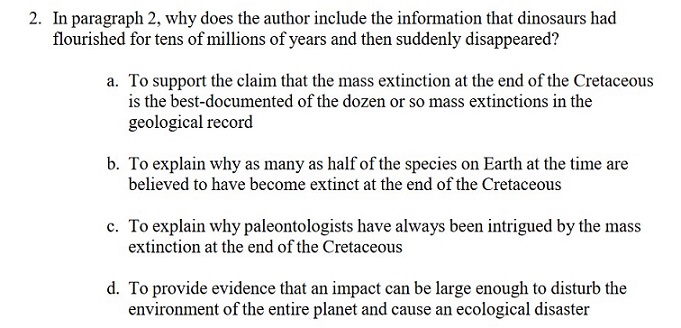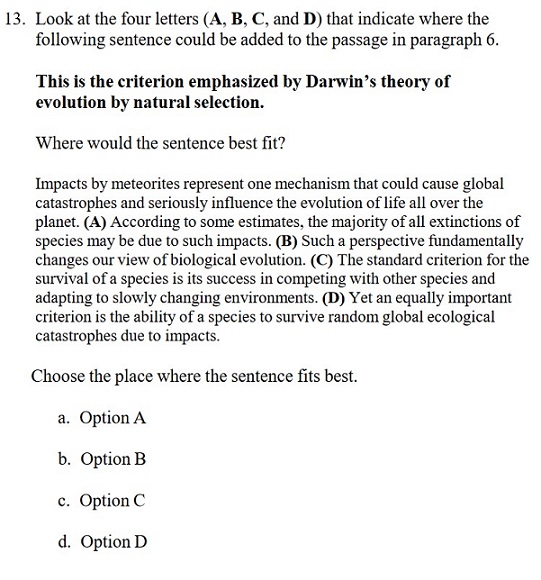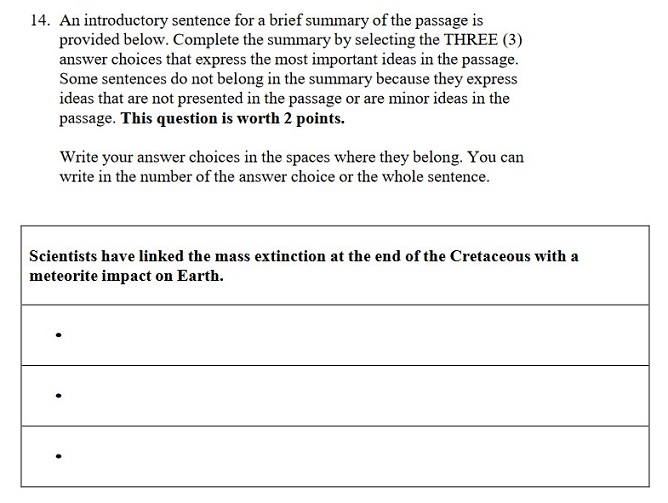
Nowhere else on the TOEFL will you be expected to read so much English and know such a wide variety of vocab words. And on top of that, you’ll have to answer dozens of questions on what you’ve read. No wonder many TOEFL students feel intimidated by the Reading section.
However, TOEFL Reading is actually one of the more straightforward sections of the exam, and knowing what to expect will make it a lot easier to ace this section on test day. Read this guide to learn exactly what types of questions you’ll see on this section and how to answer them. We also outline the best TOEFL Reading strategies to supercharge your prep and the TOEFL Reading tips that can help you get a top score on test day.
Overview of the TOEFL Reading Section
Reading is the first section on the TOEFL, and it’s designed to test your ability to understand university-level academic texts and passages. You’ll have 60-80 minutes to answer questions based on three to four passages. The variation in time and length is due to the fact that some test takers will have un-scored experimental questions in their TOEFL Reading section, making it extra long, while others will have experimental questions during their Listening section instead. You won’t know which questions are experimental and which are graded, so try not to worry about it too much.
Each of the TOEFL Reading passages will be about 700 words long, and they’ll be followed by about 12-14 questions. The passages are from university-level textbooks that introduce a topic or discipline.
What Types of Questions Are There on TOEFL Reading?
You will come across three different types of questions as you read through the TOEFL Reading passages. Since it’s important to know what to expect, in this section we explain the different types of question and, for each question type, give an official sample question and response tips.
By the way: we have built the world's best online TOEFL course. Get online practice (TPO-sytle!) and individual grading and feedback on Speaking and Writing.
To be fair, it's possible to get a good TOEFL score studying alone. But PrepScholar is the world's most effective TOEFL course if you are worried about the TOEFL and are struggling to improve your score.
Learn how you can improve your TOEFL score by 15 points today.
Standard Multiple Choice
You likely have a lot of experience with these types of questions. For each question there are four answer choices, only one of which is correct. You’ll need to choose the correct one. This is, by far, the most common question type you’ll see in TOEFL Reading. These questions may ask you about the passage as a whole, specific sentences or phrases in the passage, or the meaning of a particular word that was used.
Sample Question

TOEFL Reading Tips for Answering
- Read every answer choice. This may seem like obvious advice, but on the day of the test it’s easy to see an option that looks pretty good, choose it, and move along to the next question without checking to make sure there isn’t a better option. ETS will try to make some answer choices sound like the right answer, when they’re actually not. Reading through all your options will help you avoid getting fooled.
- Look for evidence in the passage. Every correct answer will be supported by evidence in the passage, even if it’s not immediately obvious. If you’re unsure of which answer is correct, go back and skim the passage for clues.
- To get more tips on TOEFL Reading’s tricky Inference questions, watch this video:
Inserting a Sentence
For each passage, there will be one Inserting a Sentence question. For these questions, you will be shown a paragraph from the passage, as well as a sentence that is to be added to it. There will be four different places where the new sentence can be inserted, and your job is to select the spot where the sentence best fits.
Sample Question

TOEFL Reading Tips for Answering
- For each of the four options, briefly read through the entire paragraph with the new sentence inserted into the marked place. Don’t be tempted to skim the options or stop after the first option if it sounds good enough. These questions are designed to be somewhat tricky, and there will always be answers that sound pretty good but aren’t the correct answer. By considering each placement option carefully, you’ll reduce the chance of answering incorrectly.
- Consider if the meaning of the paragraph changes depending on where the sentence is placed. The correct answer will keep the original meaning the same.
Reading to Learn
Reading to Learn questions may be less familiar to you. These questions ask you to organize the main points of the passage in either a chart or a summary. There will be one of these questions for each passage. Unlike the other Reading questions, which are all worth one point, Reading to Learn questions are worth two to three points. It is possible to get partial credit.
Sample Question


TOEFL Reading Tips for Answering
- These questions can be a bit confusing if you haven’t seen them before, so be sure to practice them while you’re studying (see next section for practice materials).
- For questions that ask you to select main ideas from the passage (like the sample question above), don’t be fooled by minor facts. It’s easy to think these are the correct answer if they’re mentioned in the passage because it seems like there’s supporting evidence, but if it wasn’t a main point of the passage, don’t include it.
- Don’t be afraid to skim the passage again if you need help answering these questions. Look for main ideas and key points that were made.
- Always double-check your answer to make sure it seems logical before moving on to the next question.
- To get more tips on TOEFL Reading’s Table questions, watch this video:
TOEFL Reading Study Strategies
This section is fairly straightforward, but you should still prepare for it in order to get your best score on test day. Use these TOEFL Reading tips to get the most out of your studying.
Take Practice TOEFL Reading Tests
Any reading that you do in English can help strengthen your skills and help you do better on the TOEFL Reading section, but it’s especially important to take practice TOEFL Reading tests. Taking practice Reading sections will help you strengthen your critical reading skills and become more familiar with the types of questions you’ll see.
We have a guide to all the best TOEFL Reading practice resources, including numerous free and official practice questions. Check it out to get some great study materials for TOEFL Reading.
Practice Reading Academic Texts
Doing practice Reading questions will help you become more familiar with the exam, but you should also be sure to read regularly in order to improve your critical reading skills. The best material to read is university-level academic texts that introduce a topic, since TOEFL Reading passages come from these types of books. Examples include any university-level books with the words “Introduction” or “Beginning” in the title (such as “Introduction to Victorian Literature” or “Beginning Zoology”. You can also look at 100-level college classes and see which textbooks they assign students. These are likely introductory texts.
If you don’t own any of these books yourself, ask a friend who has started university if you can borrow some of the books they used their first year, or visit your local library for university textbooks.
Try to read at least a few pages from these books every day. It’s more useful to do a little reading every day than to try and cram a lot of reading in at one time since this can make it hard to take in a lot of information, and it’s not as close to what TOEFL reading comprehension is like. As you read, pause every few paragraphs and think about what you’ve read. What points is the author trying to make? How are they supporting those statements? Are there any words you aren’t sure of? Try to figure out what they mean from their context, but if you still don’t know, look them up.
(Remember, you won’t need to know vocab that’s specific to a particular field or subject. For example, if you’re reading a biology textbook and come across the phrase, “The cytoplasm was transferred,” you should know what transferred means, but you don’t need to worry about cytoplasm since it’s a word you won’t often encounter outside the field of biology.) Read the next point for more tips on learning useful vocab words.
By reading academic texts regularly, you’ll improve your English reading skills and be more prepared for whatever passages the TOEFL throws at you.
Strengthen Your Vocabulary
A strong vocabulary is important for every part of the TOEFL, but it will help you most on the Reading section where you’ll come across the most words and occasionally have questions that directly ask you what a specific word means.
Reading in English regularly will help you learn new words and expand your vocabulary, and you can also check out our guide to the 327 vocab words you need to know for the TOEFL for more ideas!

Decide if Taking Notes Helps You
Some people find taking brief notes while they’re reading the passages helps them remember what they read and answer questions more easily. Others don’t get much benefit from the notes and only get slowed down by it. Before test day, you should know which method works better for you.
While you’re taking your practice TOEFL Reading tests, try taking notes for some and no notes for others. Which method helped you get a higher score? Did you find one made you feel more comfortable or confident than the other? Did you still have enough time to answer all the questions? Think about which one you prefer, and follow that method on exam day. By having your game plan set before you take the actual TOEFL, you’ll feel more confident and prepared, which can help you score higher!
TOEFL Reading Tips for Test Day
Reading is the first section you’ll complete on test day, and you’ll want to start the test on a high note. Below are four tips to help you get through the Reading section smoothly.
Want to improve your TOEFL score? We have the world's leading TOEFL course.
Built by world-class instructors from Harvard and MIT, the course offers individual review, interactive lessons, and realistic online praactice, at an affordable price! It's the fastest way to get your target TOEFL score.
Decide How You Want to Approach TOEFL Reading Passages
Like we discussed above with taking notes, different Reading strategies work best for different people, and you’ll want to have your plan of attack ready when you sit down to take the TOEFL.
How should you approach the Reading passages? Some people prefer to read the questions first so they know what to look for when reading, while others dive right into the passage. For most people, I find it’s best to start reading the passage right away since reading the questions first can eat up your time, and you’ll likely have to go back and skim the passage when answering questions anyway. However, this approach doesn’t work for everyone and, like taking notes, you should try the two methods on practice Reading sections to figure out which one works best for you. Come test day, you’ll have a plan for exactly how you’ll approach the passages and answer the questions.
Pace Yourself
If you spend an equal amount of time on each passage, you’ll have 20 minutes to read one passage and answer its accompanying 12-14 questions. That’s not a lot of time, so you’ll need to pace yourself during the exam.
Each person will have a slightly different timeline, but you should aim to spend about five minutes reading each passage and one minute answering each question. Taking practice tests will help you refine your time management skills.

Don’t Get Tripped Up on One Question
On the Reading section especially, it’s easy to get stuck on one question and keep searching the passage for some clue you’ve missed. If you’re not paying attention, you may not notice that several minutes have slipped by with you staying stuck on the same question. This can really end up hurting your score if you end up not having enough time to answer other questions, so it’s something you want to avoid.
During the exam, keep an eye on the clock or your watch, and if you’ve spent a minute on a question and still don’t know the answer, make your best guess, then move on to the next one. You can always come back to that question if you have time at the end.
Use Context Clues to Figure Out the Meaning of a Word
Even if you put a lot of time into expanding your vocabulary and memorize all the words from our vocab list above, you’ll likely still come across at least one word you’re not sure of on TOEFL Reading. When this happens, see if you can use context clues to figure out what the word means.
To do this, reread the entire sentence or even paragraph the word occurs in. Then, try to substitute a similar word that keeps the meaning of the paragraph the same. Once you’ve done that, look at the answer choices again. Are any of them close to the replacement word you chose? If yes, there’s a good chance that answer choice is the right one.
Summary: The Key to Acing TOEFL Reading
Many TOEFL students find the Reading section challenging because they have to read and analyze a lot of English in a short amount of time. Knowing what to expect and taking steps to prepare yourself can go a long way in helping you do well on this section.
While you’re studying for TOEFL Reading, be sure to take practice tests, read academic texts, strengthen your vocabulary, and figure out if taking notes while reading helps you or hurts you. On test day, during TOEFL Reading, remember to pace yourself, avoid getting stuck on one question and wasting time, and be sure to use context clues to decipher the meaning of tricky words.
What’s Next?
Not sure what TOEFL score you should be aiming for? Learn about how the TOEFL is scored and how you can figure out what a good TOEFL score for you is.
Want more tips on how to prepare for TOEFL Reading questions? Check out our guide to the best ways to practice for TOEFL Reading!
Which words do you absolutely need to know for the TOEFL? Check out our guide to learn the 327 best words to learn for the exam.
Ready to improve your TOEFL score by 15 points?
Download our best TOEFL Strategy eBook (valued at $14.49) for FREE! Learn the top 5 strategies you must know to improve your TOEFL score. Download it for free now:
